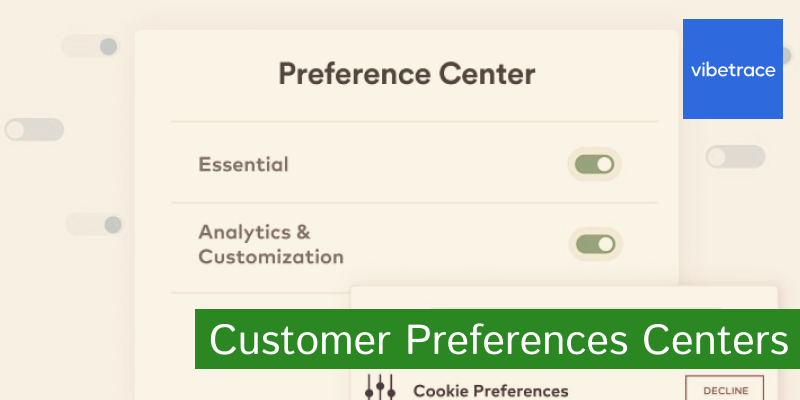Introduction
Sending emails to your customers can make them feel overwhelmed, which may make them decide to unsubscribe from your email campaigns.
Once they do that, that’s already a potential loss!
But here’s the good thing, there is a solution to this problem which most e-commerce owners struggle with.
You can have the option to use preference centers to help you reduce your email unsubscribe rates, as your customers have the option to change the frequency of emails that they receive from daily to weekly.
In fact, there are more benefits to using this kind of strategy for sending out your emails. Your email marketing will surely increase your engagement rate and help you retain more customers.
In this article, we have listed a guide to help you get started. Keep on reading, and this may be your chance to increase your email engagement faster!
The Importance of Preference Centers
An email preference center can be a page or a dashboard on a website that allows users to subscribe and customize the emails they want to receive from the business.
Implementing this on your business website will enable your subscribers to opt out of specific emails and only receive emails that resonate with them.
Although, as a rule, preference centers are not a legal requirement, such as the unsubscribe option on email, having one comes with many benefits.
This will help you reduce unsubscribe rates and have a clean mailing list as your subscribers have the chance to choose which emails they would like to receive.
Furthermore, a preference center can help you gain deeper insight into your subscribers’ interest and behavior toward their purchases, which can help you segment your email list better so you can send emails that are personalized and relevant for subscribers and make them feel exclusive.
Lastly, it helps you improve your email deliverability to make sure that all emails are delivered to the inboxes of your users, increasing visibility and even open rates.
What is a Preference Center?
A preference center is a customizable online platform or interface that allows users to manage their preferences and settings for the email content and communication they receive from your business.
Here are the three main key components of preference centers:
Email Content Preferences
Make it simple for your subscribers to select the types of emails they want to receive, the topics they’re interested in, and the language they prefer. These three factors can assist you in segmenting your mailing list and ensuring that they receive emails that are relevant to them.
Frequency and Timing of Emails
Allow your subscribers to choose how frequently they want to receive emails, whether daily, weekly, monthly, or on a different schedule.
They can also choose when they want to receive emails, allowing them to integrate communications into their daily routines.
User’s Personal Data
This component may provide users with the ability to update or modify their personal information, such as their name, email address, and contact information.
It guarantees that your business has accurate and up-to-date information in order to communicate effectively.
Types of Preference Centers
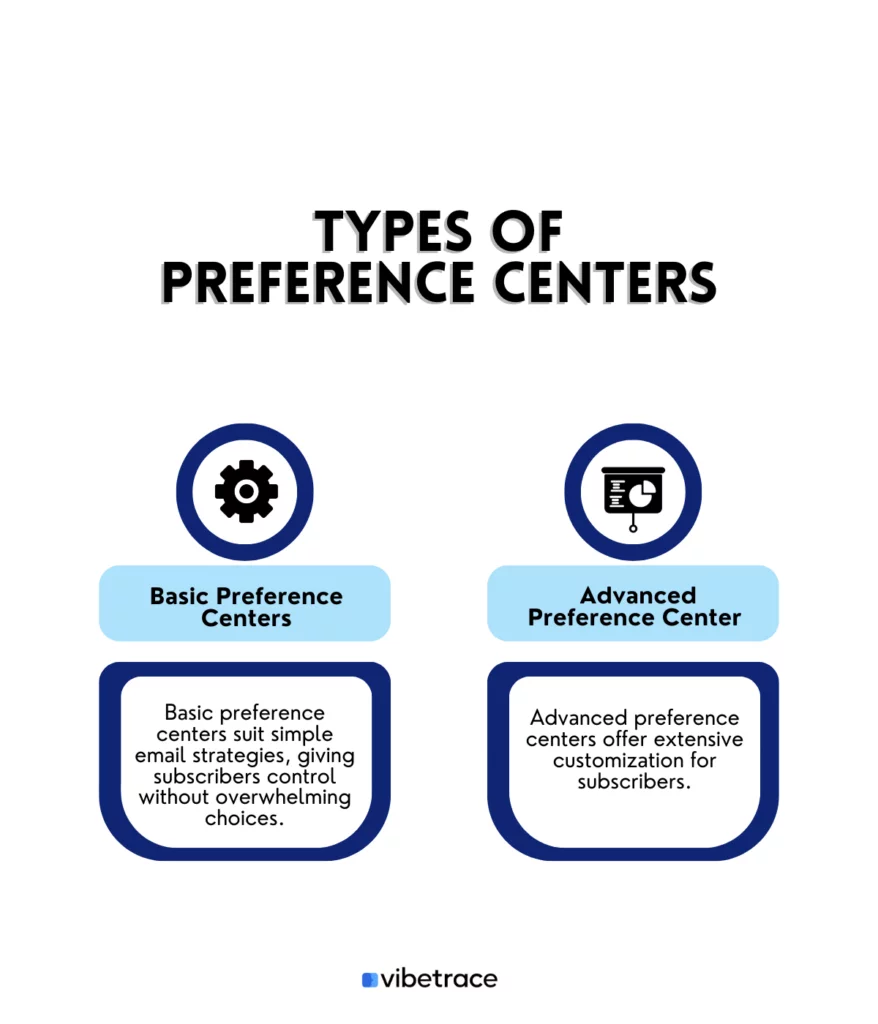
Basic
Basic preference centers are simple to set up and are appropriate for businesses with less complex email marketing strategies. You can give subscribers some control over the frequency and content of their emails without overwhelming them with options.
Here’s what you can expect in a basic preference center:
- Frequency Options: Subscribers can choose how often they receive emails (e.g., daily, weekly, monthly).
- Content Types: Subscribers can select the types of content they want to receive (e.g., newsletters, product updates, and special offers).
- Unsubscribe Option: An easy way for subscribers to opt-out of all emails if they wish to do so.
Advanced
An advanced preference center provides subscribers with a higher level of personalization and customization. It offers a more comprehensive set of options for customizing the email experience.
Here are the elements typically found in an advanced preference center:
- Frequency Options: Subscribers can choose how often they receive emails.
- Content Types: Subscribers can select specific content categories, topics, or products they are interested in.
- Personal Info: Subscribers can update their name, email address, and other contact details.
- Product Preferences: Subscribers can indicate preferences for specific product categories or types.
- Location: Subscribers can provide location information for localized content or deals.
- Opt-Out Reasons: When unsubscribing, subscribers can specify reasons for doing so, providing valuable feedback to the organization.
- Social Media Links: Options to follow the organization on various social media platforms.
- Privacy Policy: A link to the privacy policy to build trust and transparency.
- Break from Emails: Subscribers can pause email communications for a specific period instead of unsubscribing entirely.
- Preview: A feature that allows subscribers to preview how their personalized emails will look.
- Language Preferences: An option to select the preferred language for communication, if applicable.
Why You Need One
A preference center is an essential tool for any e-commerce business aiming to create a clean and substantial email list, enabling you to send customized newsletters via SMS or email based on the individual preferences of your customers.
Here’s why you should consider implementing one:
- Including preference centers is crucial for legal compliance. Many privacy regulations, such as GDPR, mandate that businesses obtain user consent before using non-essential cookies and sending direct marketing communications. Preference centers are an effective way to ensure compliance with these consent requirements.
- Preference centers offer a valuable opportunity for businesses to gain insights into their customers’ preferences and interests, facilitating the delivery of personalized messages.
- Presenting customers with topics that align with their interests using preference centers can significantly increase customer satisfaction. Customers receive content they are genuinely interested in, enhancing their overall experience.
- Allowing customers to opt in and select their preferences through preference centers can help reduce unsubscribe rates and complaints. Customers are less likely to opt out of communications when they have control over the content they receive.
Setting Up a Preference Center
Planning: What should a preference center include?
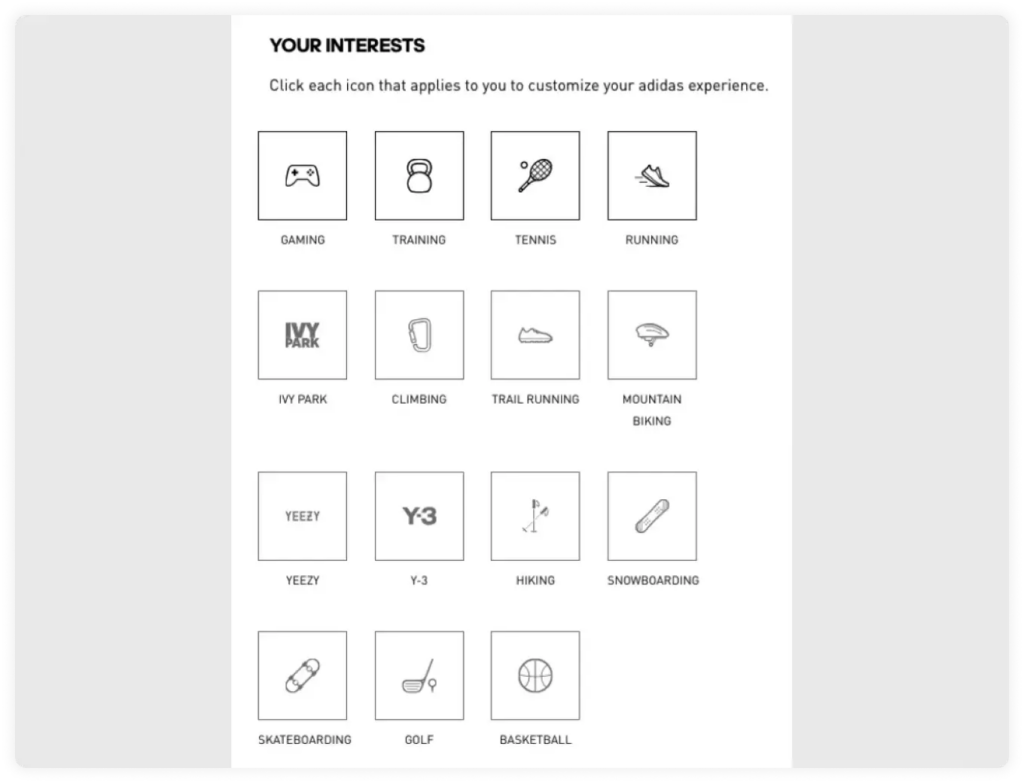
- Frequency Options: Let subscribers choose how often they want to hear from you—daily, weekly, monthly.
- Content Types: Allow them to pick the kind of content they want—newsletters, product updates, special offers, etc.
- Personal Info: A section to update their name, email, and maybe even birthday for special offers.
- Product Preferences: Let them select categories or types of products they’re most interested in.
- Location: If you offer location-specific deals or content, include an option to enter a zip code or city.
- Opt-Out Reasons: If they’re looking to unsubscribe, offer a list of reasons. This is valuable feedback.
- Social Media Links: Encourage them to follow you on other platforms.
- Privacy Policy: Always include a link to your privacy policy to build trust.
- Break from emails: give them the option to stop receiving emails for a specific period
- Unsubscribe Option: As much as you don’t want to see them go, it’s essential to include an easy way to unsubscribe.
- Preview: Allow them to preview how their personalized email would look.
- Language Preferences: If applicable, offer a language selection option.
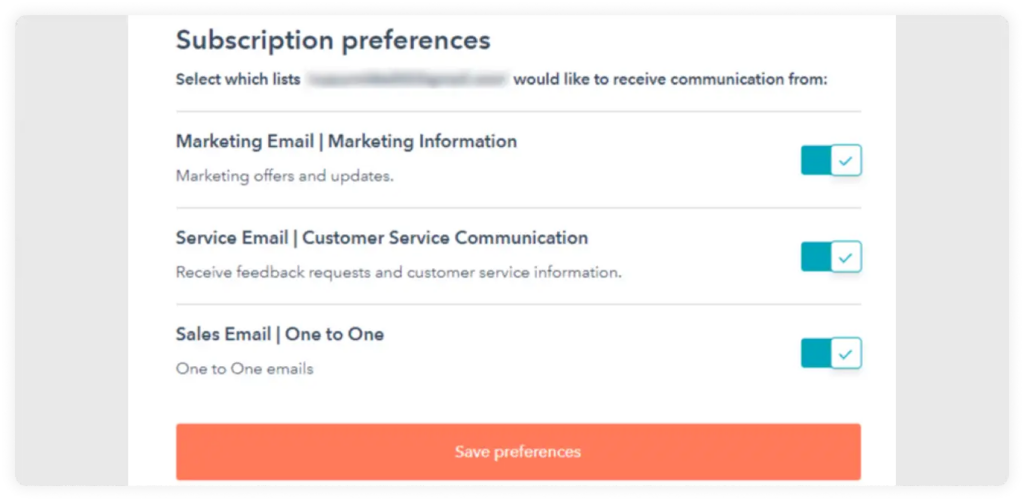
Design: When designing your preference center, it’s crucial to create a user-friendly and visually appealing interface. Here are some design considerations:
- User-Friendly Layout: Make sure the preference center is simple to use, with distinct headings and sections for each preference category.
- Mobile Responsiveness: Make sure the preference center is mobile-friendly, as many subscribers will use their smartphones or tablets to access it.
- Intuitive Icons and Buttons:For actions such as saving preferences, updating personal information, or unsubscribing, use easily recognizable icons and buttons.
- Visual Consistency: Maintain a consistent color scheme and branding elements to reassure subscribers that they are still interacting with your brand.
- Progress Indicator: If the preference center involves multiple steps or sections, include a progress indicator to show subscribers how far they’ve come in the process.
- Error Handling: Implement clear error messages and guidance for users if they encounter any issues while updating their preferences.
Implementation: After planning and designing your preference center, it’s time to implement it effectively. Here’s how to go about it:
- Integrate with Email Marketing Software: Ensure that your preference center seamlessly integrates with your email marketing software or customer relationship management (CRM) system.
- Secure Data Handling: Implement robust security measures to protect subscribers’ personal information and preferences.
- Testing: Before launching the preference center, thoroughly test it to identify and fix any usability issues or bugs.
- Compliance: Ensure that your preference center complies with data privacy regulations, such as GDPR or CAN-SPAM, by obtaining necessary consents and providing clear information about data usage.
- User Authentication: If necessary, implement user authentication measures to verify subscribers’ identities before allowing them to make changes to their preferences.
- Confirmation Emails: Send a confirmation email to subscribers after they update their preferences to confirm the changes and provide a record of their selections.
- Regular Updates: Keep the preference center up-to-date with any changes in your email marketing strategy, content types, or available products and services.
- Customer Support: Provide easily accessible customer support options for subscribers who may have questions or encounter issues while using the preference center.
- Feedback Collection: Encourage subscribers to provide feedback on the preference center’s usability and functionality, and use this feedback to make improvements.
- Monitoring and Reporting: Implement tracking and reporting mechanisms to monitor subscriber preferences and the overall effectiveness of your preference center.
Best Practices
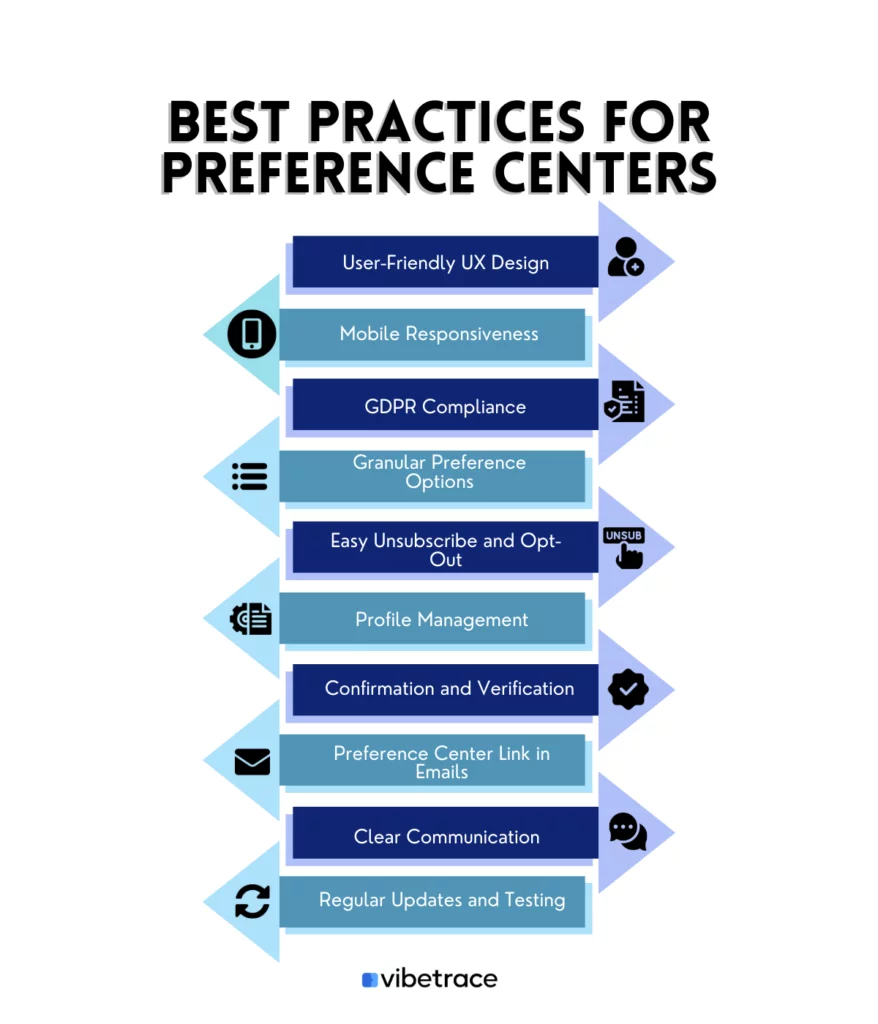
User-Friendly UX Design: If you are implementing a preference center, you should prioritize providing a user-friendly design that makes it easy for your subscribers to navigate and manage their preferences. Take note to make use clear language, intuitive icons, and organized categories to ensure users can quickly find and update their preferences without frustration.
Want to be up to date with Marketing?
Subscribe to our Retail CX newsletter!

Stay connected with what’s really important to optimize your digital revenues.
By clicking the button, you accept our Terms & Conditions. Also you will need to confirm your email address.
Mobile Responsiveness: You must ensure that the preference center is fully mobile-responsive. Many of the users access emails and websites on their mobile devices, so it’s crucial that the preference center functions that you implement is seamlessly on smartphones and tablets, with easy-to-use touch controls and a layout that adapts to different screen sizes.
GDPR Compliance: Adhere to GDPR (General Data Protection Regulation) guidelines, especially if you collect and store personal data. You must provide transparent explanations of how user data will be used, offer opt-in and opt-out choices, and allow users to easily delete their accounts or data if they choose to do so. Include a clear privacy policy and consent mechanisms.
Granular Preference Options: You can try to offer granular preference options that allow users to customize their content and communication preferences. This includes selecting the frequency of emails, specific topics of interest, and the types of communication they wish to receive (e.g., newsletters, promotions, transactional emails).
Easy Unsubscribe and Opt-Out: Make it straightforward for users to unsubscribe or opt-out from communications. Include a prominent unsubscribe link in emails and the preference center. Ensure that unsubscribing is a simple, one-click process without requiring users to log in or provide additional information.
Profile Management: Provide users with the ability to create and manage their profiles. This includes updating contact information, changing passwords, and editing personal details. A user-friendly interface for profile management enhances the overall experience.
Confirmation and Verification: Implement a confirmation or verification process for any changes made in the preference center. This helps prevent unauthorized changes and ensures that users have control over their preferences and data.
Preference Center Link in Emails: Include a link to the preference center in every email communication. This allows users to easily access and update their preferences whenever they interact with your content, increasing the likelihood that they will stay engaged with your brand.
Clear Communication: Use clear and concise language throughout the preference center. Avoid jargon or complex terminology that might confuse users. Clearly explain the purpose of each preference setting and its potential impact on their experience.
Regular Updates and Testing: Continuously update and test the preference center to ensure it remains functional and user-friendly. Monitor user feedback and analytics to identify any pain points and make improvements accordingly.
Case Studies
NewRelic Preferences Center
New Relic is organizing it’s preferences center based on resource types (sales, events, general, webinars).
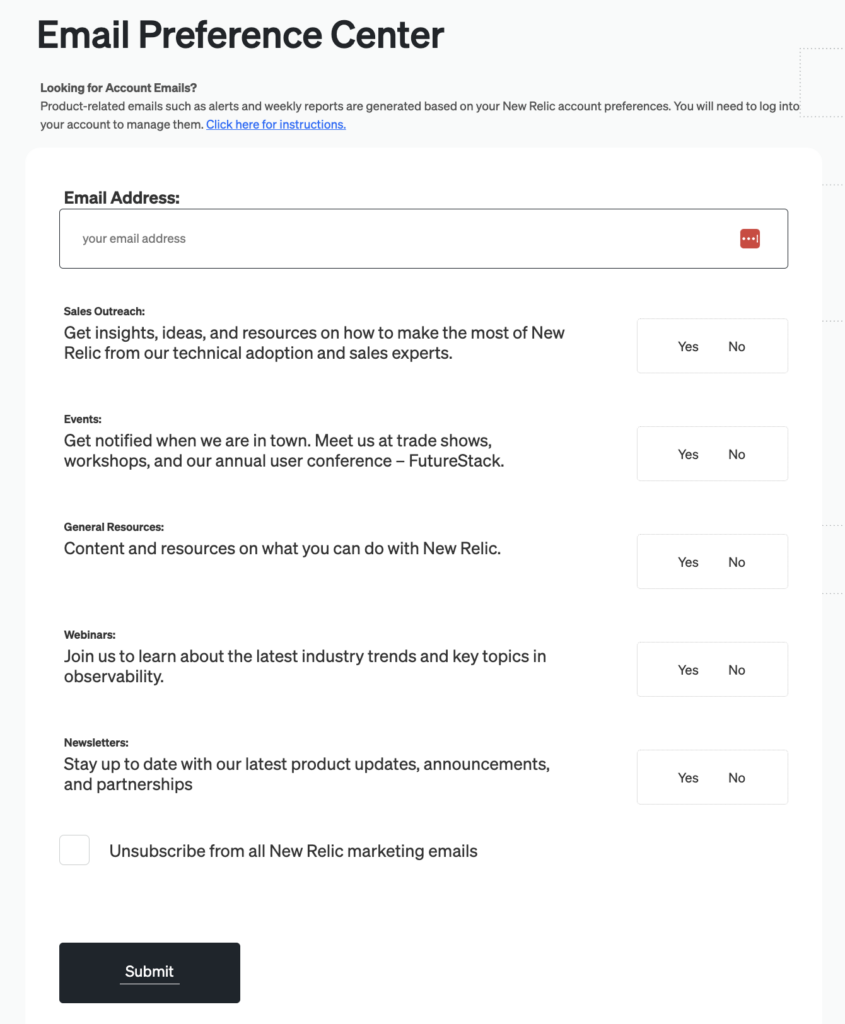
PC Magazine
PC Magazine has multiple topics related to information you can receive through their system.
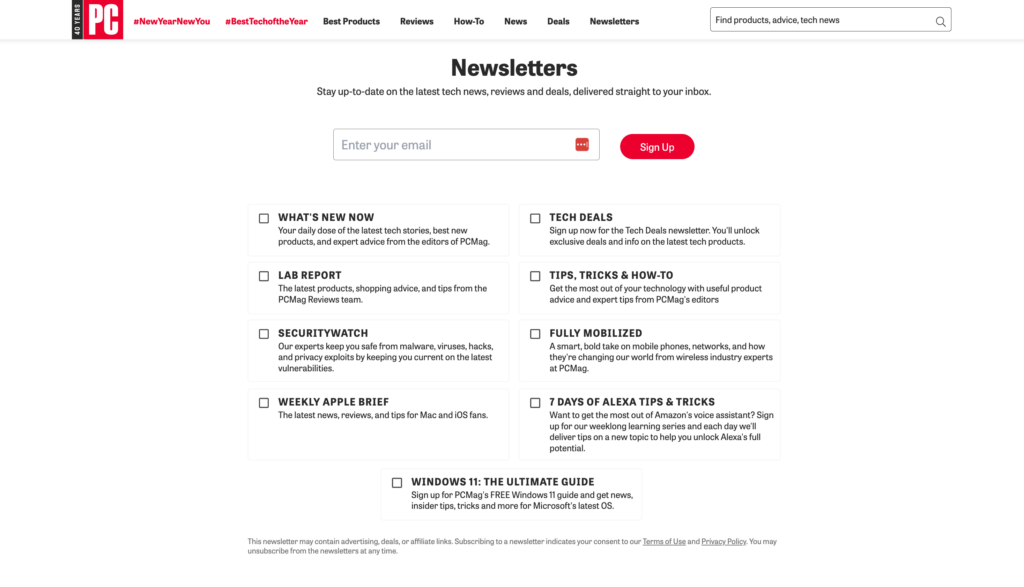
Reuters Preference Center
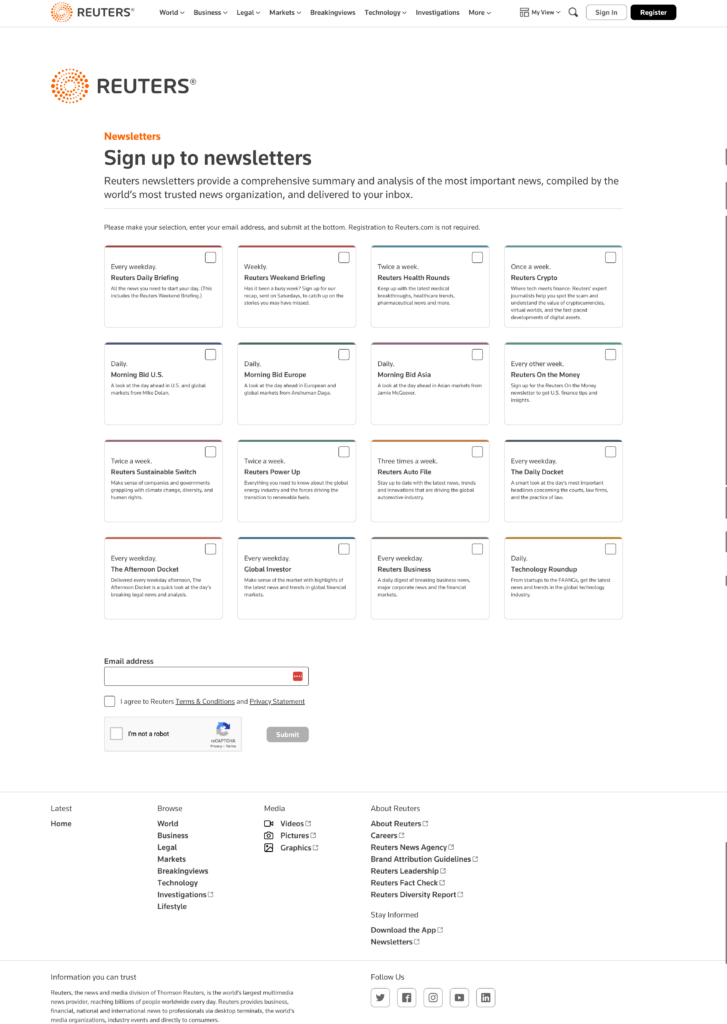
UBS Switzerland
UBS is the biggest bank in Switzerland. They provide a multi language preference center where users can choose language and specific subscriptions.
First section shows you the personal information you’ve introduced when subscribing.
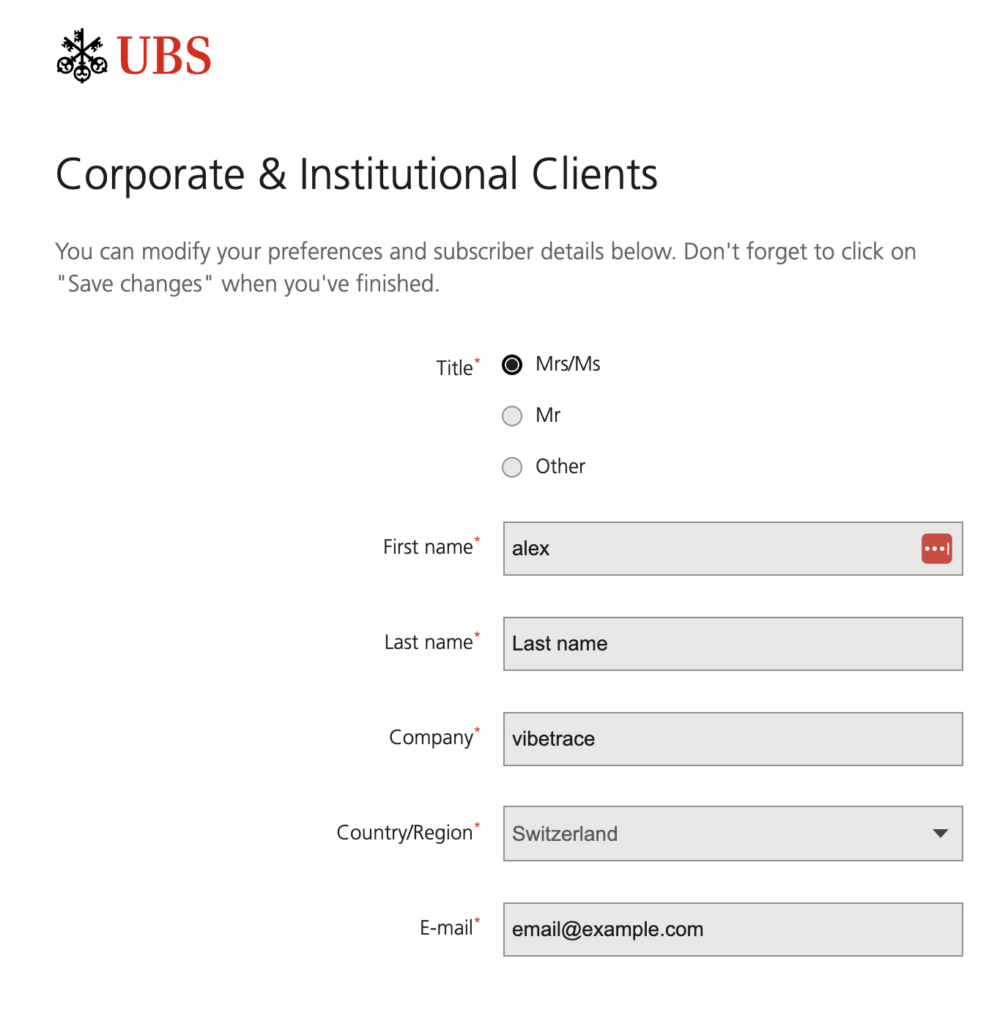
The second section is about subscriptions. For each of them you can choose the language you want to receive your emails.
Also there is a link at the bottom that allows you to unsubscribe from all emails.
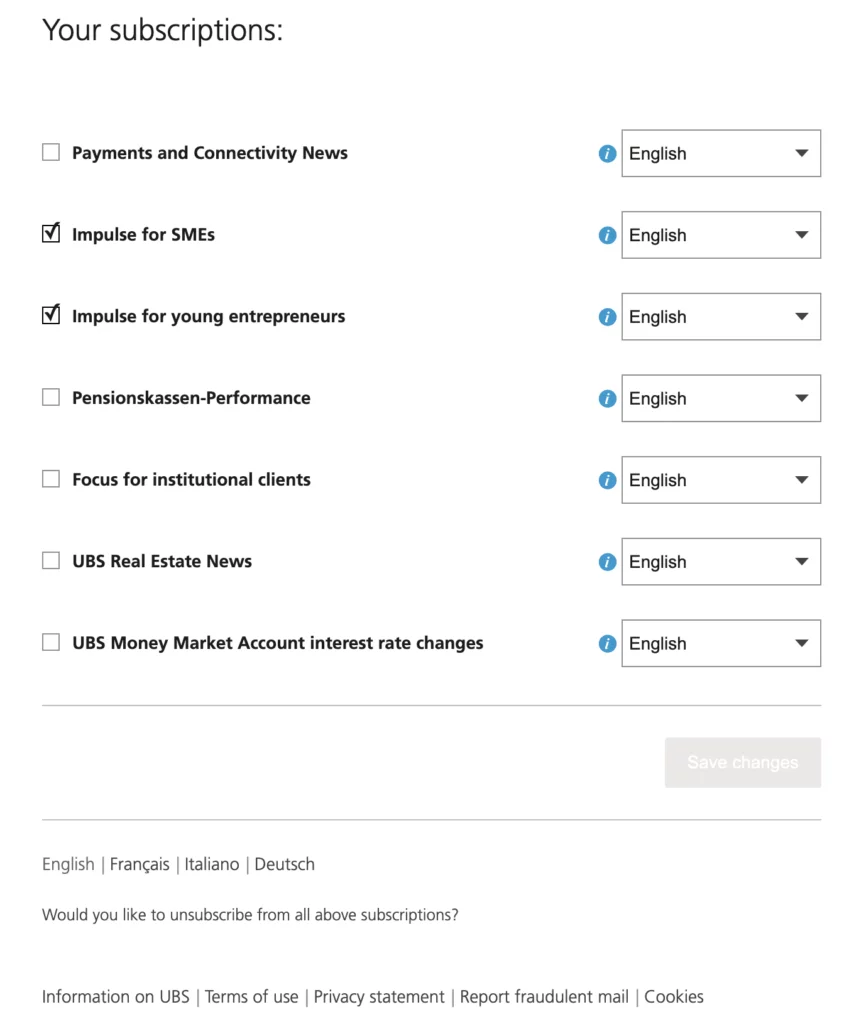
Hubspot style preference center
MorpheaBed Preferences Center
This preference center from Morphea Bed allow you to:
- change desired language for the emails
- select from desired types of communications:
- marketing information
- customer service
- one-to-one emails (I expect those would be the one that are manually sent)
- simply unsubscribe from all emails
Swisslos.ch Preferences Center
It’s an online lottery where you can buy tickets online for specific games (they call them products)
Swisslos allows you to editor preferences in a very detailed style. Because they have multiple products, Swisslos also provides a granular center to only receive the information you’re interested in.
Secondly, they have the concept of providing “product information newsletter” but also “notifications” for specific games.
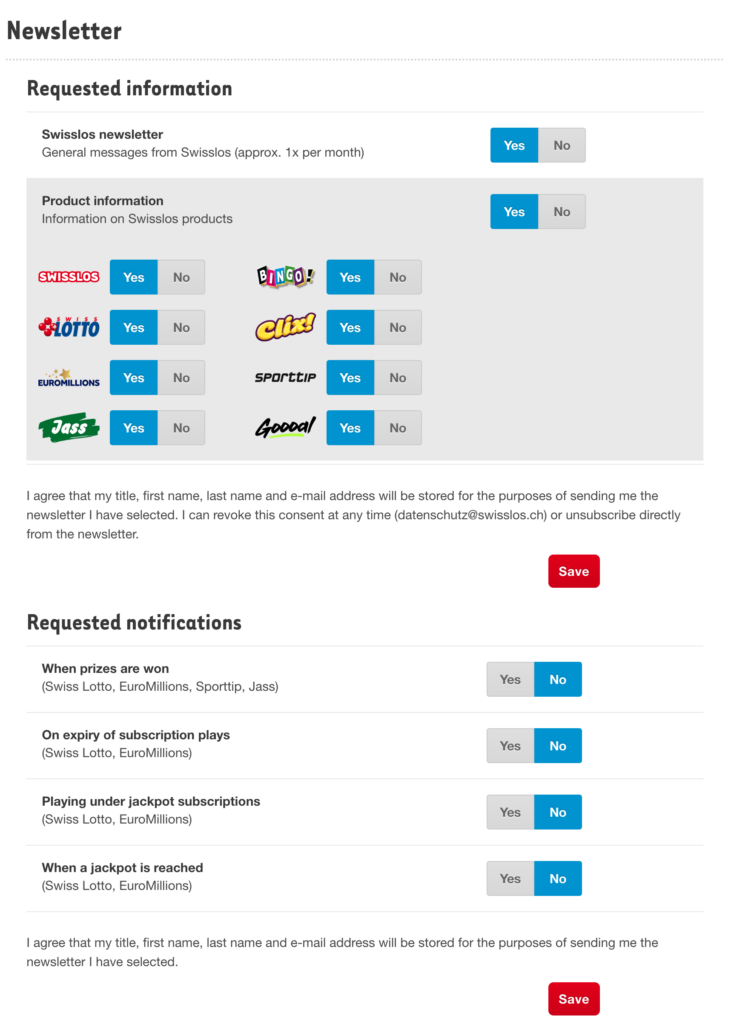
Common Mistakes to Avoid
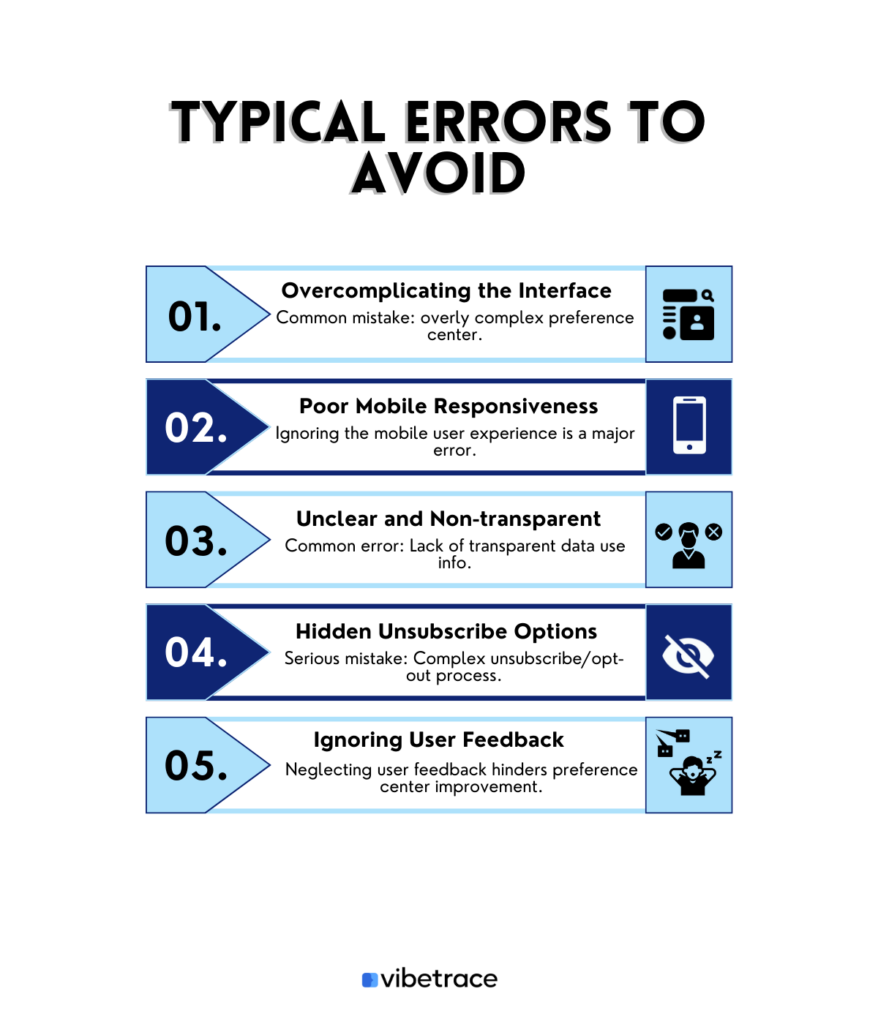
Overcomplicating the Interface: One of the most common mistakes is overcomplicating the preference center interface. Too many options, complex menus, or a cluttered layout can overwhelm users and make it difficult for them to update their preferences. Keep the design simple and user-friendly to ensure a positive experience.
Inadequate Mobile Responsiveness: Neglecting the mobile experience is a significant mistake. Many users access emails and websites on mobile devices. If your preference center is not optimized for mobile screens and touch interactions, it can frustrate users and lead to high bounce rates.

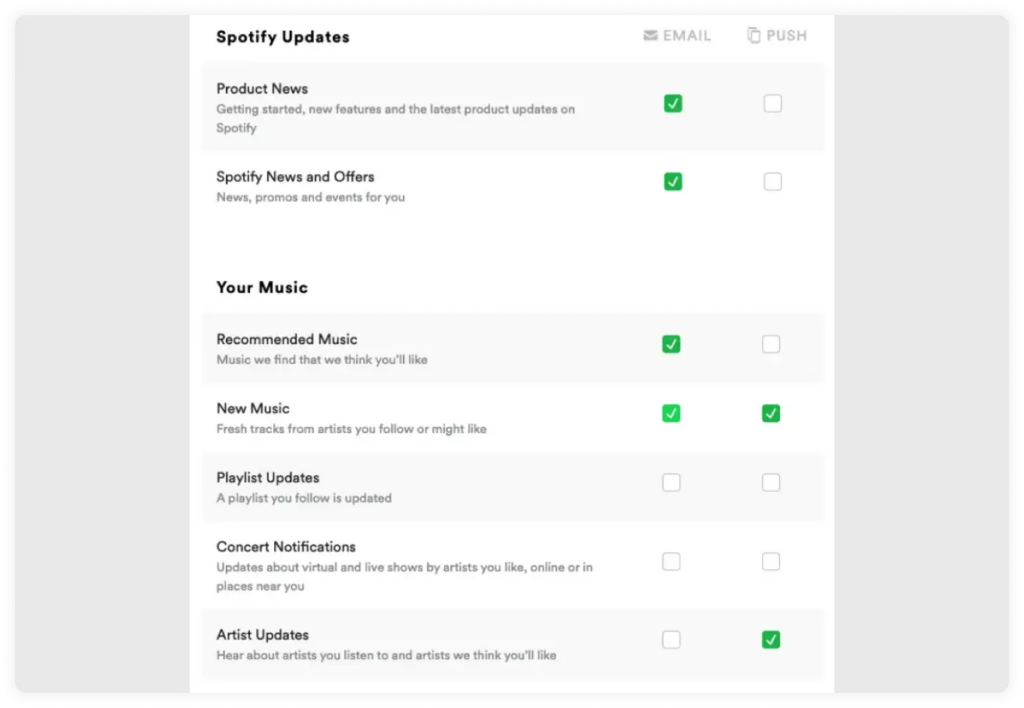
Lack of Clarity and Transparency: Failing to provide clear and transparent information about how user data will be used and what each preference setting entails is a common error. Users should fully understand the implications of their choices. Avoid jargon or vague language that might confuse or mislead them.
Hidden Unsubscribe Options: Making it difficult for users to unsubscribe or opt out of communications is a serious mistake. Users should be able to easily find and use the unsubscribe link or button, both within emails and on the preference center page. Hiding or obfuscating this option can lead to spam complaints and a negative brand reputation.
Ignoring User Feedback: Neglecting to gather and act upon user feedback is a mistake that can hinder the improvement of your preference center over time. Regularly solicit feedback from users and pay attention to their preferences and concerns. Failure to make necessary adjustments based on feedback can result in a less-than-ideal user experience.
How to Measure Success
Retention Rate: Calculate the retention rate for users who have customized their preferences compared to those who haven’t. A higher retention rate among the former group indicates the impact of personalized content on retaining users.
Time on Site: Measure how much time users spend on the preference center page. A longer average time on site suggests that users are engaged and taking the time to customize their preferences.
Open Rates: Track open rates specifically for emails that have been personalized based on user preferences selected in the preference center. Compare these open rates to generic or non-personalized emails. Higher open rates for personalized content indicate that users find it more relevant and engaging.
Click-Through Rates (CTR): Measure the click-through rates for links or calls-to-action (CTAs) within emails sent to users who have customized their preferences. Compare these CTRs to those for users who haven’t updated their preferences. A higher CTR for personalized content suggests greater user engagement.
Conversion Rate: Calculate the conversion rate for users who have interacted with the preference center and received personalized content. This conversion rate should reflect the percentage of users who took a desired action, such as making a purchase, signing up for a webinar, or filling out a form, as a result of personalized communication.
Conclusion
To wrap it up,

